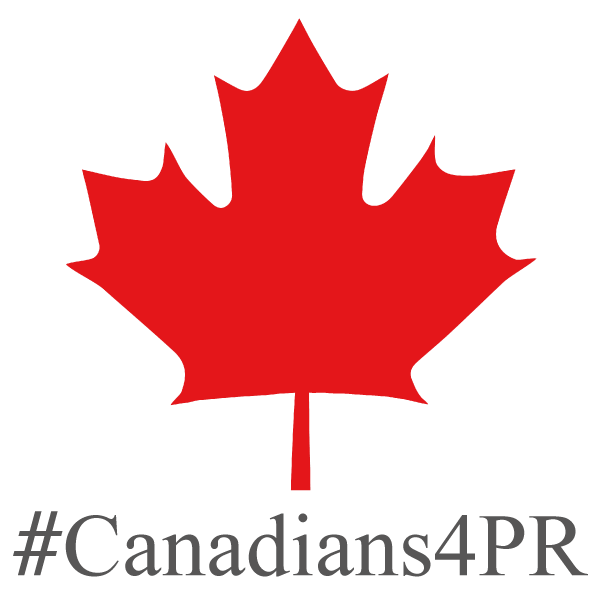Proportional Representation is any electoral system that results in a government whose makeup is proportional to what voters voted for. If 40% of voters voted for Party X, then 40% of the seats will be given to Party X.
Proportional Representation is very common throughout the world
Proportional voting systems are very foreign to those who have always used First-Past-the-Post, however they are actually very common voting systems used all over Europe and across the world. Currently, 87 democracies all over the world use proportional voting systems. In fact, of all OECD countries (countries economically similar to Canada), only Canada, the US, and the UK still use FPTP.
Proportional Representation is not a single system.
Unlike FPTP, there are many different systems of PR. This can range from pure proportional, where candidates are selected from a list to match the proportion of votes for each party, to systems that are much like Canada’s, where voters can directly elect local candidates as well as regional candidates. There are many ways that proportionality can be achieved, and systems of PR tend to be customized to the needs of each country or province.
The most common Proportional systems
The most commonly used proportional systems are Party List PR, Mixed Member Proportional, and Single Transferable Vote.
Party List PR is the simplest system. With Party List PR, candidates are elected from a closed list or open list in proportion to the number of votes each party received. In a closed list, the candidates are selected by the parties. In an open list, the voter can vote for their preference of candidates. However, because our country is so large, having representation tied to geographical areas is important, so this is not a system that has ever been recommended for Canada.
- https://www.samaracanada.com/samara-in-the-classroom/electoral-reform/list-proportional-representation
- https://en.wikipedia.org/wiki/Party-list_proportional_representation
Mixed Member Proportional is the PR system that most closely resembles Canada’s current voting system and has been recommended by the Law Commission of Canada. With MMP, voters cast two votes, one for a local representative and one for the party they support. The party vote is used to determine how many candidates need to be added to a region in order to make the result in that region proportional. In Canada, this can be achieved without changing the number of MP’s we currently have or the distribution MP’s allotted to each province. Learn more about how MMP can work for Canada here:
- https://www.fairvote.ca/mixed-member-proportional/
- https://elections.bc.ca/referendum/voting-systems/mixed-member-proportional-mmp/
- https://thetyee.ca/Analysis/2018/10/11/MMP-Keeps-MLAs-Local-Regional/
- https://www.samaracanada.com/samara-in-the-classroom/electoral-reform/mixed-member-proportional-representation/
- https://en.wikipedia.org/wiki/Mixed-member_proportional_representation#Current_usage
- Videos
Single Transferable Vote is used by only two countries so far but is commonly advocated by political scientists. The voter ranks candidates, and as votes are counted and a winner declared, 2nd and 3rd choices are used to declare successive winners until all the positions are filled in a certain region. Again, STV can be implemented in Canada without changing the distribution of MP’s we have now. STV is also a recommended fairer option for municipal elections. Here are some links to STV:
- https://www.fairvote.ca/stvbc/
- https://en.wikipedia.org/wiki/Single_transferable_vote
- https://www.samaracanada.com/samara-in-the-classroom/electoral-reform/single-transferable-vote
- Videos
Any proportional system produces better results than what we have.
These are just three of the many types and variations of proportional voting systems used throughout the world. Although it can be confusing trying to sort out the pros and cons of each system, in the end no matter which system we choose, the end goal is a proportional result, something that an overly simple FPTP system can never achieve. That is a step in the right direction.
If changing the voting system is important to you, keep in touch. Sign the petition, take the Canadians4PR Pledge, subscribe to the email updates, follow us on Facebook, and take some small actions that make a big difference!


